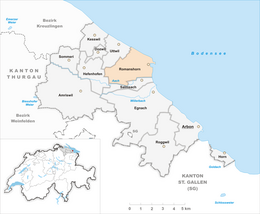Romanshorn
| Romanshorn | ||
|---|---|---|
 |
||
|
||
| Coordinates: 47°34′N 9°23′E / 47.567°N 9.383°ECoordinates: 47°34′N 9°23′E / 47.567°N 9.383°E | ||
| Country | Switzerland | |
| Canton | Thurgau | |
| District | Arbon | |
| Government | ||
| • Mayor | David H. Bon | |
| Area | ||
| • Total | 8.75 km2 (3.38 sq mi) | |
| Elevation | 406 m (1,332 ft) | |
| Population (Dec 2015) | ||
| • Total | 10,753 | |
| • Density | 1,200/km2 (3,200/sq mi) | |
| Postal code | 8590 | |
| SFOS number | 4436 | |
| Surrounded by | Friedrichshafen (DE-BW), Hefenhofen, Immenstaad am Bodensee (DE-BW), Salmsach, Uttwil | |
| Website |
www SFSO statistics |
|
Romanshorn is a municipality in the district of Arbon in the canton of Thurgau in Switzerland.
Romanshorn was probably settled in the 7th Century, and is first mentioned in 779 as Rumanishorn in a land grant from Waldrata to the Abbey of St. Gall. During the Late Middle Ages and until 1367, the bailiwick of Romanshorn was partially owned by the Landsberg family. In 1455 Abbot Kaspar Landsberg sold the Romanshorn estate to the city of St. Gallen, but his religious superiors forced the courts to repeal the sale. Until 1798, the Abbey of St. Gall owned the taxation, appellate court and the homage rights (mostly in Täschlishusen at Häggenschwil) with the remaining sovereignty owned by the County of Thurgau.
In 779 a church was mentioned in Romanshorn. In 1275, the records of the church indicate that the Provost was paid 16 pounds. In 1480 St. Gallen incorporated a church in Romanshorn. The church was expanded in 1504. Then, in 1525 the Protestant Reformation entered Romanshorn and much of the population converted. The federally. In 1588, the Reformed priest in Salmsach was appointed to care for Romanshorn as well. The church remained a filial church until the creation of the Romanshorn-Salmsach parish. It wasn't until 1567 that the abbot appointed a Roman Catholic priest to Romanshorn. The next year, a rectory was built and a sinecure was granted. The number of Catholics slowly grew (1588 there were 2 families and in 1711 there were 36 families). The church was renovated in 1829. It remained a shared church until 1911 when a Protestant church was completed. Two years later a Catholic church was also completed.
...
Wikipedia




